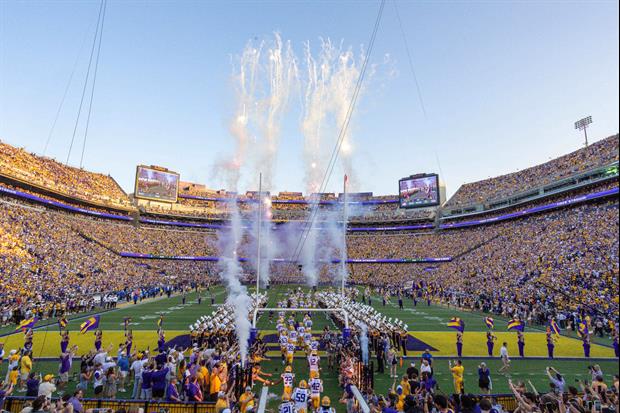- My Forums
- Tiger Rant
- LSU Recruiting
- SEC Rant
- Saints Talk
- Pelicans Talk
- More Sports Board
- Coaching Changes
- Fantasy Sports
- Golf Board
- Soccer Board
- O-T Lounge
- Tech Board
- Home/Garden Board
- Outdoor Board
- Health/Fitness Board
- Movie/TV Board
- Book Board
- Music Board
- Political Talk
- Money Talk
- Fark Board
- Gaming Board
- Travel Board
- Food/Drink Board
- Ticket Exchange
- TD Help Board
Customize My Forums- View All Forums
- Topic Sort Options
- Trending Topics
- Recent Topics
- Active Topics
TheFretShack
| Favorite team: | |
| Location: | |
| Biography: | |
| Interests: | |
| Occupation: | |
| Number of Posts: | 1342 |
| Registered on: | 10/28/2015 |
| Online Status: | Not Online |
Recent Posts
Message
re: Black Sabbath Volume 4
Posted by TheFretShack on 11/11/25 at 5:38 pm to midnight1961
Vol. 4 and Master of Reality

re: Blackberry Smoke Tonight in BR
Posted by TheFretShack on 10/31/25 at 7:31 pm to TheFretShack
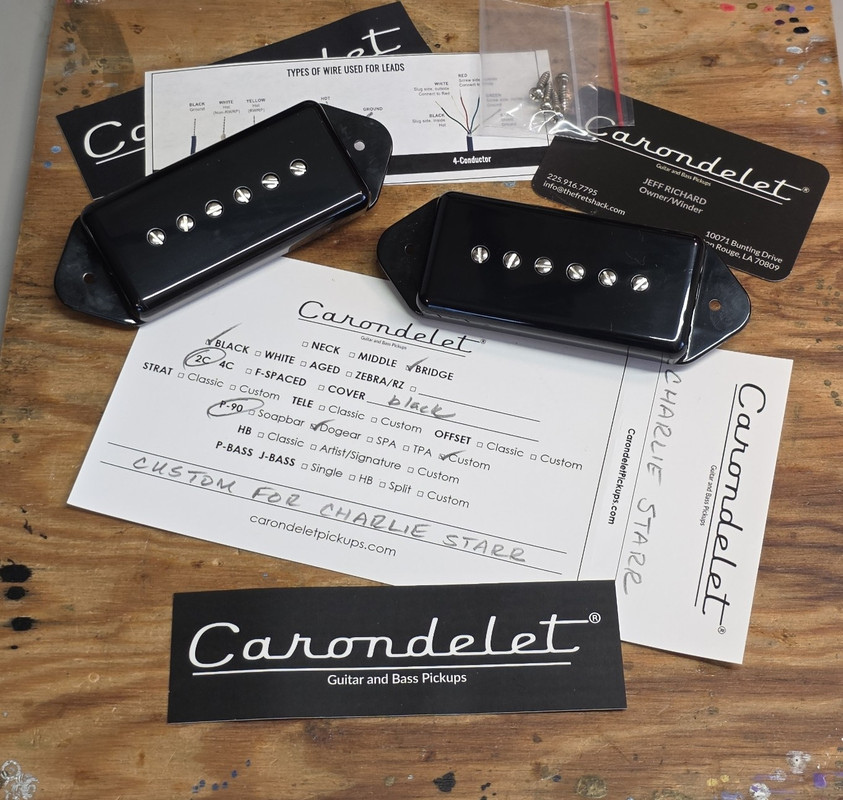

re: Blackberry Smoke Tonight in BR
Posted by TheFretShack on 10/31/25 at 7:28 pm to yallgood
From my social media feeds ...
A mutual friend put Carondelet P-90s on Charlie Starr's radar last year and he's been a friend and a fan ever since.
Charlie invited me to Blackberry Smoke's soundcheck in Baton Rouge yesterday (!), and no pickup winder meets up with modern Southern rock's patron saint of P-90s without something special in tow.
Behold three very custom Carondelet "Hog Ear" dog-ear P-90s, inspired by Charlie and hand-wound by yours truly to Charlie's preferred specs.
Specifically, an overwound (9k DCR) pure vintage Gibson single coil blueprint, featuring two roughcast A4 magnets, vintage inspired metallurgy, and an unpotted coil wound with 1950s spec enamel-insulated wire.
Charlie has two of the Carondelet customs, and he said one goes asap into a project '58 Les Paul Junior he has back home, so it can join the Smoke touring guitarsenal (!).
The third custom "hog ear" resides in my personal '55 Junior, which I brought to soundcheck so Charlie could get a relevant test drive. Raw Android A/V video snippet below. The amp is Charlie's go-to 1960 brownface Fender Concert combo.
Carondelet P-90 test drive with Charlie Starr
A mutual friend put Carondelet P-90s on Charlie Starr's radar last year and he's been a friend and a fan ever since.
Charlie invited me to Blackberry Smoke's soundcheck in Baton Rouge yesterday (!), and no pickup winder meets up with modern Southern rock's patron saint of P-90s without something special in tow.
Behold three very custom Carondelet "Hog Ear" dog-ear P-90s, inspired by Charlie and hand-wound by yours truly to Charlie's preferred specs.
Specifically, an overwound (9k DCR) pure vintage Gibson single coil blueprint, featuring two roughcast A4 magnets, vintage inspired metallurgy, and an unpotted coil wound with 1950s spec enamel-insulated wire.
Charlie has two of the Carondelet customs, and he said one goes asap into a project '58 Les Paul Junior he has back home, so it can join the Smoke touring guitarsenal (!).
The third custom "hog ear" resides in my personal '55 Junior, which I brought to soundcheck so Charlie could get a relevant test drive. Raw Android A/V video snippet below. The amp is Charlie's go-to 1960 brownface Fender Concert combo.
Carondelet P-90 test drive with Charlie Starr
re: Lace Sensor Pickups
Posted by TheFretShack on 10/28/25 at 8:26 am to Shanegolang
there is a note on the zip lock bag it's in that says "5th string pole lost volume" I assume it's repairable??
Sounds like the pole, which is a rod magnet, was somehow demagnetized. If that's the issue, I have a machine that supplies a good as new easy, fast fix, meaning it's a cheap fix too.
And thanks for the kind words, you're in good hands with Patrick on the installation and whatever else TLC.
Sounds like the pole, which is a rod magnet, was somehow demagnetized. If that's the issue, I have a machine that supplies a good as new easy, fast fix, meaning it's a cheap fix too.
And thanks for the kind words, you're in good hands with Patrick on the installation and whatever else TLC.
re: Wasp: Wasp - 1984
Posted by TheFretShack on 10/24/25 at 11:31 am to MaxxPain2
The name was inspired by a wasp buzzing around first bassist Rik Foxx when he and Blackie were trying to come up with a name for their new band, formed from the ashes of Blackie and Randy Piper's former band. Circus Circus.
Blackie came up with the idea of adding periods between the letters of "wasp" so it would appear to be some sort of acronym. The hope was fans, the press, anti-fans, etc., would speculate all kinds of crazy stuff, kind of like when Bible belt conservatives in the late 70s accused Kiss of being short for "Knights in Satan's Service." Then Wasp, like Kiss, would refuse to confirm or deny whatever fans or the press speculated the initials stood for, adding to the mystique.
To add fuel to the fire, they put "we are sexual perverts" in the debut album's liner notes but offered no explanation.
The name, the alleged acronym, the stage act, etc., eventually got Tipper Gore's PMRC crosshairs on them, which subsequently sold a ton of records.
So it worked.
Blackie came up with the idea of adding periods between the letters of "wasp" so it would appear to be some sort of acronym. The hope was fans, the press, anti-fans, etc., would speculate all kinds of crazy stuff, kind of like when Bible belt conservatives in the late 70s accused Kiss of being short for "Knights in Satan's Service." Then Wasp, like Kiss, would refuse to confirm or deny whatever fans or the press speculated the initials stood for, adding to the mystique.
To add fuel to the fire, they put "we are sexual perverts" in the debut album's liner notes but offered no explanation.
The name, the alleged acronym, the stage act, etc., eventually got Tipper Gore's PMRC crosshairs on them, which subsequently sold a ton of records.
So it worked.
re: Anyone Try Nylon Strings on a Steel String Acoustic?
Posted by TheFretShack on 10/7/25 at 9:08 am to Mizz-SEC
Do a Google search for "silk and steel" strings. They are made to give steel strings a softer, more playable feel and sound. Great string for children, new players, players suffering from arthritis and/or weak joints, or for who don't have player calluses.
re: G&L Guitars Out of Business
Posted by TheFretShack on 10/7/25 at 7:35 am to SingleMalt1973
G&L's biggest problem historically was their inability to effectively tell what could be (have been) American guitar-making's best story, at least in a way that that was able to convert ads, impressions, page views, etc., into actual sales.
If I was the CEO of FMIC, knowing I have the personnel and the ad/marketing budget to work with ... I'd pay whatever reasonable price I could to acquire G&L. What's at stake? Not only the G&L name, but Clarence Leo Fender's name and signature in all forms; rights and usage to every G&L, CLF and/or Leo-owned Music Man patent and IP I could get my hands on; the actual G&L facility (the old pre-CBS plant, down to tooling and Leo's office, untouched since his passing); unfinished prototypes; all of Leo's notes; and the list likely goes on.
First thing I'd do would be to move the Fender Custom Shop and the Fender Museum "back" to the old Fullerton plant. Then I'd execute a MASSIVE ad/marketing/promo campaign telling G&L's "coming home" story and why anyone should care. You'd be surprised how the people who know the story behind the G&L headstocks, MFD pickups, the Dual Fulcrum and Saddle Lock bridges, the PTB circuitry, etc. ... focus on Leo's ingenuity and innovation and reasoning for it, rather than surface cosmetics.
Here's my '96 Legacy. I've owned it longer than any guitar in my playing history. It has my pickups, my preferred wiring circuit, a Fret Shack refret with super jumbos, a trunk and fingerboard conversion from the stock satined poly finish to hand-rubbed Danish oil. I've had people offer me trades worth ten times more my G&L's value, the guitar is just such an incredible example of a S style solidbody. Not for sale. Especially now.
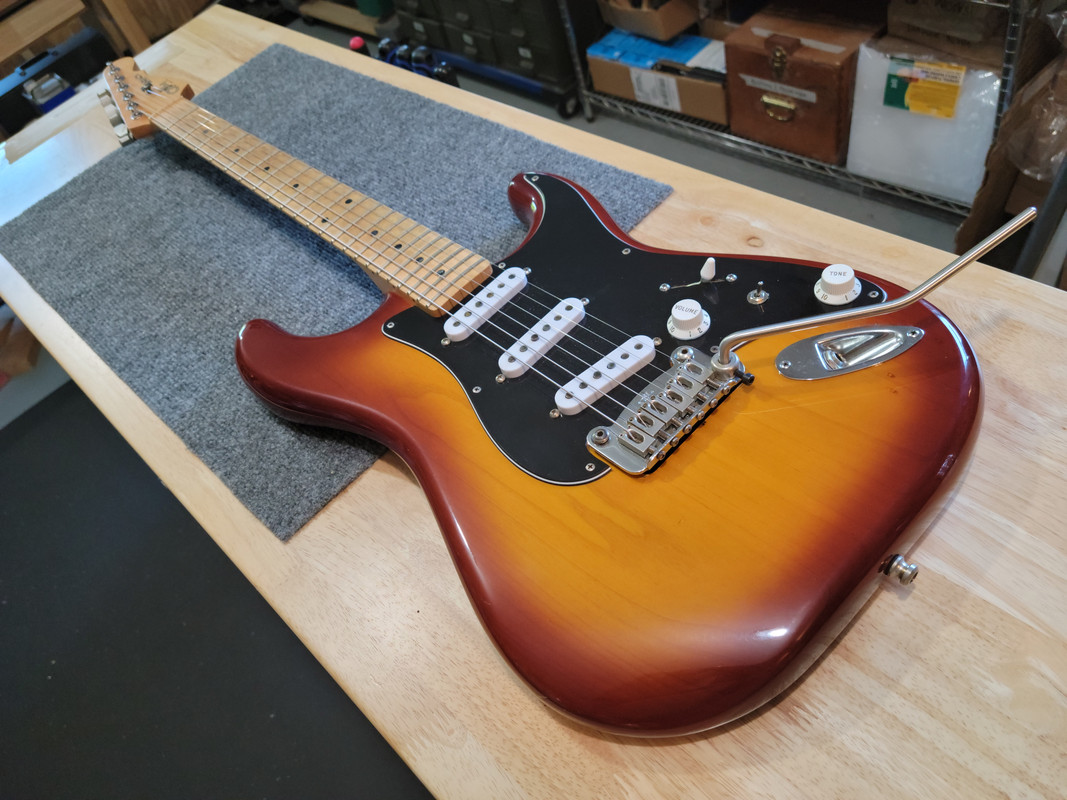
If I was the CEO of FMIC, knowing I have the personnel and the ad/marketing budget to work with ... I'd pay whatever reasonable price I could to acquire G&L. What's at stake? Not only the G&L name, but Clarence Leo Fender's name and signature in all forms; rights and usage to every G&L, CLF and/or Leo-owned Music Man patent and IP I could get my hands on; the actual G&L facility (the old pre-CBS plant, down to tooling and Leo's office, untouched since his passing); unfinished prototypes; all of Leo's notes; and the list likely goes on.
First thing I'd do would be to move the Fender Custom Shop and the Fender Museum "back" to the old Fullerton plant. Then I'd execute a MASSIVE ad/marketing/promo campaign telling G&L's "coming home" story and why anyone should care. You'd be surprised how the people who know the story behind the G&L headstocks, MFD pickups, the Dual Fulcrum and Saddle Lock bridges, the PTB circuitry, etc. ... focus on Leo's ingenuity and innovation and reasoning for it, rather than surface cosmetics.
Here's my '96 Legacy. I've owned it longer than any guitar in my playing history. It has my pickups, my preferred wiring circuit, a Fret Shack refret with super jumbos, a trunk and fingerboard conversion from the stock satined poly finish to hand-rubbed Danish oil. I've had people offer me trades worth ten times more my G&L's value, the guitar is just such an incredible example of a S style solidbody. Not for sale. Especially now.

re: Vintage guitar fret job - Is it worth it to spend $$ on an older guitar?
Posted by TheFretShack on 9/26/25 at 4:54 pm to Crow Pie
That $300-350 ... is that for a refret or for a level, recrown and polish? I ask because $350 would be considered very cheap for a refret in most reputable shops, or very expensive for a LCP (even via Plek) in most reputable shops. If the tech to whom you spoke at whatever shop didn't specify more than "fret job," get that question asked before you hand your guitar over. FWIW a $350 refret would have me personally as leery as a $1.99 steak dinner. Don't know if I wanna roll those dice.
It needs fretwork because you played the OEMs down to nothing. Guitars that suck don't get played to that extreme. So it is a no-brainer that you love playing the guitar and that alone makes it worth the investment in the fret bed. Especially if you throw in the sentimental/heirloom value, it's a Matsumoku build (superb), plus any and every other significant factor I could go on and on about.
If you want The Fret Shack to take a look at it, call 917-789-3371 and talk to Patrick Welborn to set up an appointment for inspection, diagnosis and cost estimates. All that is free of charge. He is our new full-time luthier and tech at Fret Shack and he is GOOD. I still own Fret Shack but my focus nowadays is Carondelet.
If you come to see Patrick, you can also talk to me about pickup upgrades.
It needs fretwork because you played the OEMs down to nothing. Guitars that suck don't get played to that extreme. So it is a no-brainer that you love playing the guitar and that alone makes it worth the investment in the fret bed. Especially if you throw in the sentimental/heirloom value, it's a Matsumoku build (superb), plus any and every other significant factor I could go on and on about.
If you want The Fret Shack to take a look at it, call 917-789-3371 and talk to Patrick Welborn to set up an appointment for inspection, diagnosis and cost estimates. All that is free of charge. He is our new full-time luthier and tech at Fret Shack and he is GOOD. I still own Fret Shack but my focus nowadays is Carondelet.
If you come to see Patrick, you can also talk to me about pickup upgrades.
re: Best "Marshall in a box" pedal?
Posted by TheFretShack on 9/26/25 at 4:05 pm to Jef75
re: Players, what’s on the board?
Posted by TheFretShack on 9/17/25 at 6:20 pm to TheFretShack
And right after I posted, USPS delivers two more VERY modified versions of classic Nashville dirt circuits (ODR-1 and Mostortion) from one of my pedal builder buds. Christmas in September.

Andromeda demo
Quantum demo

Andromeda demo
Quantum demo
re: Players, what’s on the board?
Posted by TheFretShack on 9/17/25 at 5:37 pm to wareaglepete
I have too many pedals and subsequently an ever evolving pedalboard.
My newest pursuit is fuzz pedals and man, what an insane rabbit hole in which to fall. Not only do you have a seemingly endless variety of classic circuits (fuzz faces, tone benders, muffs), you have inconsistency from unit to unit in many of those circuits, especially those that use Ge transistors. I see now why Eric Johnson says he buys every vintage Fuzz Face he comes across and then resells 95 percent of them for not making the cut.
My favorite fuzz pedals this week (LOL) are VERY modified triangle and ram's head clones built by friends; an AMZ Tweed Stack kit built by a friend; and the actual TB Mark 1.5 clone seen and heard in this video ... 66 Bender by Manlay Sound (Spain)
My "must have" effect is delay (atop the amp, always on) and my go-tos are a Source Audio Collider or the TC Electronic Flashback for my high gain amp. I have a Boss Waza Craft version of the DM-2 that is stellar with my old Fender combo.
My favorite "out in front" pedals are the Source Audio Spectrum for envelope filtering (I can't use a pedal wah after my left heel was surgically reconstructed); and the Boss Super Phaser PH-2 for the occasional swirlywhirl.
My newest pursuit is fuzz pedals and man, what an insane rabbit hole in which to fall. Not only do you have a seemingly endless variety of classic circuits (fuzz faces, tone benders, muffs), you have inconsistency from unit to unit in many of those circuits, especially those that use Ge transistors. I see now why Eric Johnson says he buys every vintage Fuzz Face he comes across and then resells 95 percent of them for not making the cut.
My favorite fuzz pedals this week (LOL) are VERY modified triangle and ram's head clones built by friends; an AMZ Tweed Stack kit built by a friend; and the actual TB Mark 1.5 clone seen and heard in this video ... 66 Bender by Manlay Sound (Spain)
My "must have" effect is delay (atop the amp, always on) and my go-tos are a Source Audio Collider or the TC Electronic Flashback for my high gain amp. I have a Boss Waza Craft version of the DM-2 that is stellar with my old Fender combo.
My favorite "out in front" pedals are the Source Audio Spectrum for envelope filtering (I can't use a pedal wah after my left heel was surgically reconstructed); and the Boss Super Phaser PH-2 for the occasional swirlywhirl.
re: You have $2,000 to spend on guitar(s):
Posted by TheFretShack on 9/10/25 at 12:39 pm to auggie
Labor is more expensive in the USA vs Asia, no question. But be aware that Gibson is NOT union labor. That is one of the main reasons Gibson moved from Kalamazoo (unionized Michigan) to Nashville, TN ... to evade unions.
Other factors that contribute to the higher cost of USA labor vs Asian labor is the former's employee health, dental, eye and life insurance packages, retirement packages, paid vacation and sick leave, workman's comp and other liability insurances, periodic merit and cost of living raises and promotions. AKA, things we all need and want from our employers.
Most players absolutely can afford an expensive guitar, but the approach to gear over the last three decades has favored quantity as much if not more than quality. Look at the catalyst question on this thread for an example, the should I get one "great" or two "good" instruments. When I was younger, we all had one nice electric, one decent backup, one nice acoustic, and that was it. Today, however, that's the exception, not the rule. Most of my clients have no less than a half dozen guitars, with many imports in the mix. Because they can be obtained so easily and cheaply.
Meanwhile, to test affordability alongside price, I just pulled a major retailer's page for a brand new vintage sunburst Gibson SJ-200. Without even looking at my credit score, income or household expenses, the retailer's page says they can put that $5,700 guitar in my hands for $119 a month for 48 months with zero interest.
Google tells me that is equal to the average monthly cable TV bill in America; and about $30 less than the average monthly cell phone bill in America. So nope, if someone wants and fiscally prioritizes owning a really nice, expensive American guitar instead of a half dozen Asian also-rans, there are ABSOLUTELY ways to make it affordable.
Other factors that contribute to the higher cost of USA labor vs Asian labor is the former's employee health, dental, eye and life insurance packages, retirement packages, paid vacation and sick leave, workman's comp and other liability insurances, periodic merit and cost of living raises and promotions. AKA, things we all need and want from our employers.
Most players absolutely can afford an expensive guitar, but the approach to gear over the last three decades has favored quantity as much if not more than quality. Look at the catalyst question on this thread for an example, the should I get one "great" or two "good" instruments. When I was younger, we all had one nice electric, one decent backup, one nice acoustic, and that was it. Today, however, that's the exception, not the rule. Most of my clients have no less than a half dozen guitars, with many imports in the mix. Because they can be obtained so easily and cheaply.
Meanwhile, to test affordability alongside price, I just pulled a major retailer's page for a brand new vintage sunburst Gibson SJ-200. Without even looking at my credit score, income or household expenses, the retailer's page says they can put that $5,700 guitar in my hands for $119 a month for 48 months with zero interest.
Google tells me that is equal to the average monthly cable TV bill in America; and about $30 less than the average monthly cell phone bill in America. So nope, if someone wants and fiscally prioritizes owning a really nice, expensive American guitar instead of a half dozen Asian also-rans, there are ABSOLUTELY ways to make it affordable.
re: You have $2,000 to spend on guitar(s):
Posted by TheFretShack on 9/8/25 at 6:23 pm to auggie
I've had a few "inspired by Gibson" Epis cross the bench. Nicest modern era Epi acoustics yet, I'll give them that. But $1500 for a Chinese-made acoustic new or around $1,000 used is hard to swallow when I can get a clean used American-made Gibson J-45 Studio Walnut or the Rosewood variant for similar pricing. But that's just me, your YMMV
re: You have $2,000 to spend on guitar(s):
Posted by TheFretShack on 9/7/25 at 11:48 am to FirstCityDawg
With a $2K budget, I'd buy a Gibson Les Paul Classic or SG Standard, before I'd buy anything Epiphone(s). Similar scenario for acoustics, I'd get the nicest J series Gibson I can get within budget before I'd get two Epiphone anything.
Regardless of the path, shop for clean used pieces to maximize bang for buck.
Regardless of the path, shop for clean used pieces to maximize bang for buck.
re: Building partscasters
Posted by TheFretShack on 8/21/25 at 10:24 am to rexorotten
The best partscaster advice I can offer on this and/or future builds is to ALWAYS get your body, your neck and the pickguard from the same source, whatever that source may be, if at all possible.
If you don't, and if your handpicked-from-different-vendors parts come back even a fraction of a mm or so off each other in spec, you will create a lot more work for yourself modifying the parts to make them work together, from both fit and finish and functionality perspectives. In the case of the latter, yes, one degree of mismatched tilt in the body pocket, one extra or one missing mm of neck heel thickness, etc. can completely throw off the geometry needed for the guitar to actually play well.
And there will likely be not so attractive trace evidence of your making mismatched parts work together. Chipped paint around the neck pocket and poorly fit pickguards are the most common uh-ohs I see.
With XGP, you will likely need a pro fret leveling, recrowning and polishing to get best performance results, and gauged-file-cut nut slotting, so budget in farming that out if you can't do it yourself.
Segue into my most recent pickup demo build ... that's yummy candy tangerine thin-skin nitro ...
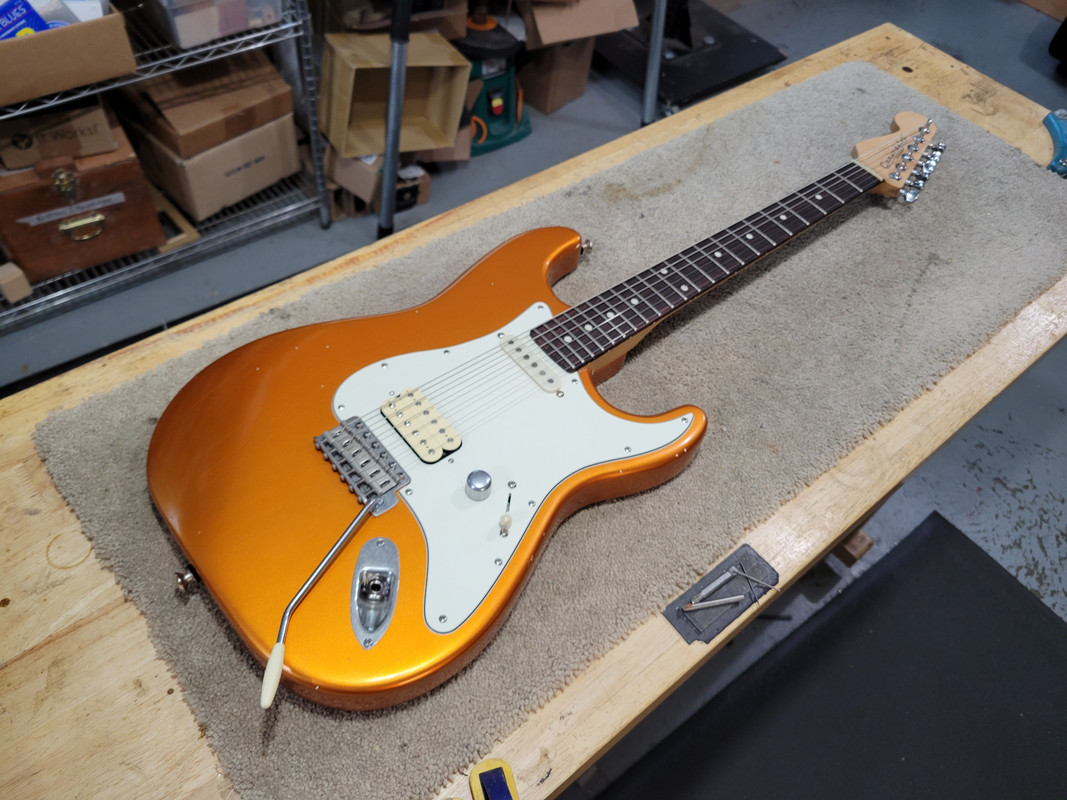


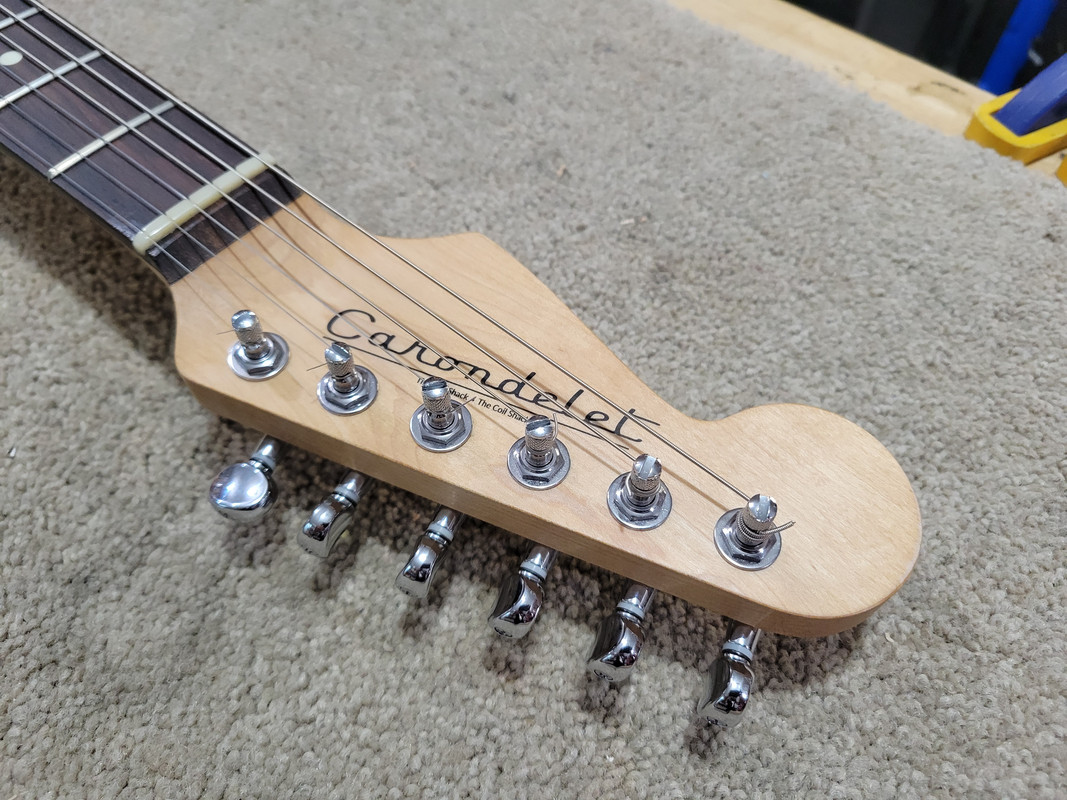
If you don't, and if your handpicked-from-different-vendors parts come back even a fraction of a mm or so off each other in spec, you will create a lot more work for yourself modifying the parts to make them work together, from both fit and finish and functionality perspectives. In the case of the latter, yes, one degree of mismatched tilt in the body pocket, one extra or one missing mm of neck heel thickness, etc. can completely throw off the geometry needed for the guitar to actually play well.
And there will likely be not so attractive trace evidence of your making mismatched parts work together. Chipped paint around the neck pocket and poorly fit pickguards are the most common uh-ohs I see.
With XGP, you will likely need a pro fret leveling, recrowning and polishing to get best performance results, and gauged-file-cut nut slotting, so budget in farming that out if you can't do it yourself.
Segue into my most recent pickup demo build ... that's yummy candy tangerine thin-skin nitro ...




re: New really old guitar day !
Posted by TheFretShack on 8/16/25 at 11:46 am to midnight1961
Here's my 1215 Archtone from the late 40s/early 50s. I haven't found the inkstamp with the suffix of the production year to date, I think it was never stamped.
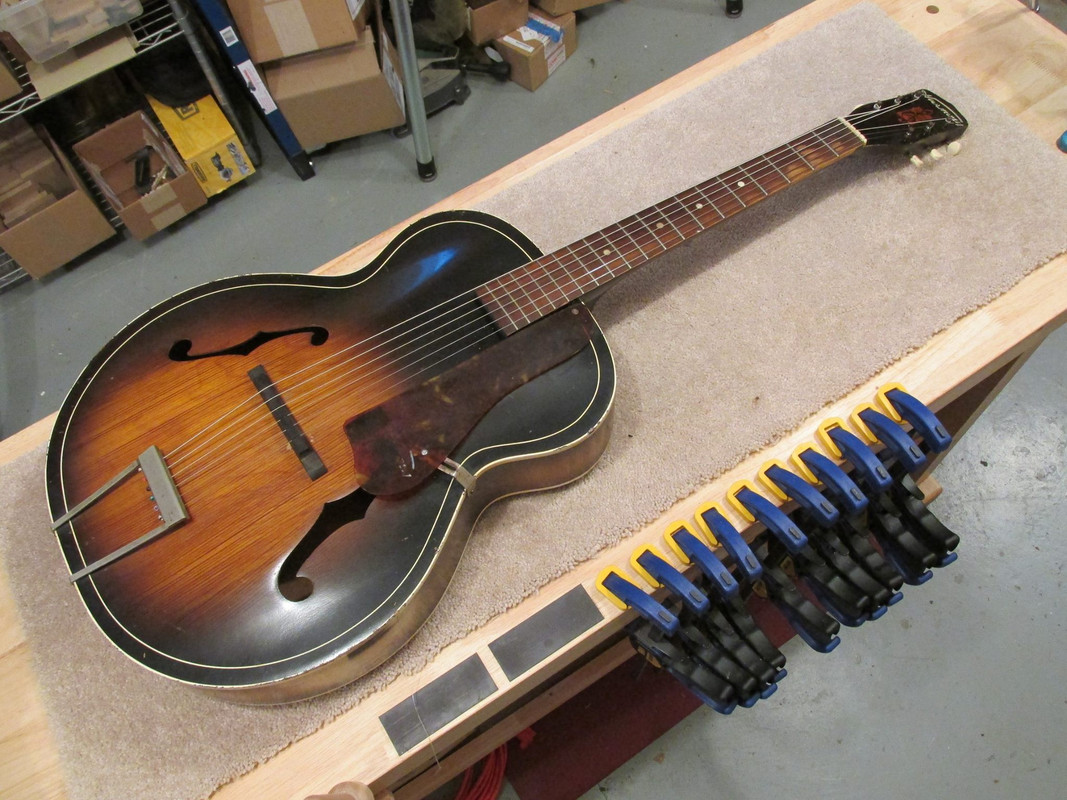
The Archtone 1215 is made out of birch, the entire guitar. Interesting wood choice in that you will recall birch is not a guitar tonewood, it is traditionally a drumshell wood.
Where it gets fun ... The Archtone's birch top has faux grain lines painted on to make the soundboard look like spruce; and the birch sides and back have faux quilt added to make it look like figured maple; and the birch fingerboard is reddish browned to look like rosewood.
I espied it in the back corner of a Plank Road pawn shop about 10 years ago and scored it for I think $200 cash out the door. It plays and sounds absolutely phenomenal which is insane considering it's never had a neck reset. Or if it did, it was among the most pro and cleanest I've ever seen - zero trace evidence.
You made a STELLAR score!

The Archtone 1215 is made out of birch, the entire guitar. Interesting wood choice in that you will recall birch is not a guitar tonewood, it is traditionally a drumshell wood.
Where it gets fun ... The Archtone's birch top has faux grain lines painted on to make the soundboard look like spruce; and the birch sides and back have faux quilt added to make it look like figured maple; and the birch fingerboard is reddish browned to look like rosewood.
I espied it in the back corner of a Plank Road pawn shop about 10 years ago and scored it for I think $200 cash out the door. It plays and sounds absolutely phenomenal which is insane considering it's never had a neck reset. Or if it did, it was among the most pro and cleanest I've ever seen - zero trace evidence.
You made a STELLAR score!
re: Any Amp Stand Recommendations?
Posted by TheFretShack on 7/16/25 at 6:50 pm to auggie
Before you spend your money on an amp stand, put it on a chair and see if that gives you throw and projection you seek. Experiment with more midrange too, that will help you penetrate the mix.
You will have your work cut out for you ... 50 solid state modeler watts may simply not be enough for the application.
Also, if you guys are jamming with a PA ... mike the amp.
You will have your work cut out for you ... 50 solid state modeler watts may simply not be enough for the application.
Also, if you guys are jamming with a PA ... mike the amp.
re: Fender Tone Master Deluxe Reverb
Posted by TheFretShack on 7/14/25 at 10:54 am to composerdave
Take the target OD pedals with you to GC and set up an A/B with the TMDR and an all-tube Fender BF or SF reissue of some sort in your preferred size/weight and see if you get better results.
Also, there is a reason the Fender Twin Reverb - BF, SF, RIs - is the most common backline amp in the business. Big, rich, gorgeous cleans with seemingly infinite headroom ... and they love any and all pedals, modelers, fly-rigs, whatever you juice them with. The only drawback is they are big and heavy - which is why I mentioned start with preferred size/weight tube Fenders.
For what it's worth, the best pedal host amp I've ever used in my playing life was an early 70s SS rectifier non-master vol SFTR. MV comps from the mid-70s can probably be found in the current market for around what you paid for that TMDR. And if you're in BR, I have an amp tech that can make that amp SING.
Also, there is a reason the Fender Twin Reverb - BF, SF, RIs - is the most common backline amp in the business. Big, rich, gorgeous cleans with seemingly infinite headroom ... and they love any and all pedals, modelers, fly-rigs, whatever you juice them with. The only drawback is they are big and heavy - which is why I mentioned start with preferred size/weight tube Fenders.
For what it's worth, the best pedal host amp I've ever used in my playing life was an early 70s SS rectifier non-master vol SFTR. MV comps from the mid-70s can probably be found in the current market for around what you paid for that TMDR. And if you're in BR, I have an amp tech that can make that amp SING.
re: Acid Bath - The Caverns - Grundy, TN (3/21/26)
Posted by TheFretShack on 7/8/25 at 6:40 pm to Hetfield
I have no info on any upcoming shows in or near NOLA, sorry.
re: Acid Bath - The Caverns - Grundy, TN (3/21/26)
Posted by TheFretShack on 7/8/25 at 5:16 pm to SLCGumpFB25
YouTube canned my video for trademark reasons tied to the video's intro music, which is ironic considering the writer/composer of the music in question is the subject and star of the video LOL
The video can be viewed without hassles on Carondelet's Instagram page.
https://www.instagram.com/carondeletpickups/
The video can be viewed without hassles on Carondelet's Instagram page.
https://www.instagram.com/carondeletpickups/
Popular
 1
1





